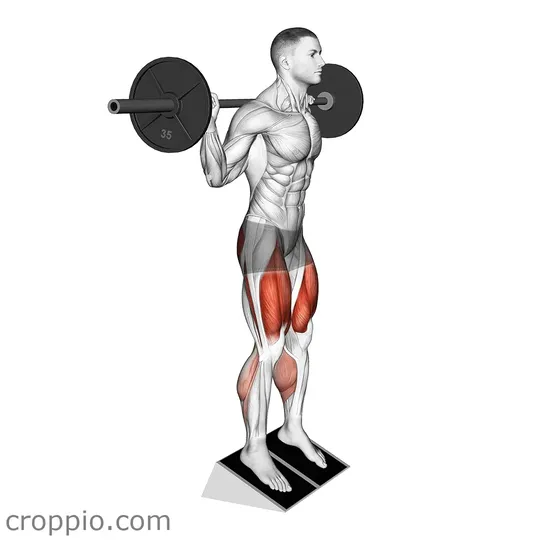Heel Elevated Squat Muscles Used

Muscles Involved
The heel elevated squat is a dynamic exercise that primarily targets the quadriceps. By elevating the heels during the squat, there is increased emphasis on the thigh muscles, allowing for enhanced quad engagement. Secondary muscles activated during the exercise include the glutes, hamstrings, calves, and core stabilizers. This configuration promotes improved balance and coordination, while also facilitating increased depth in the squat movement.
Top Mistakes
- Wrong Foot Placement: Placing the feet too wide or too narrow can lead to improper form and limit muscle activation.
- Leaning Forward: Excessively leaning the torso forward during the squat can shift the focus away from the target muscles and strain the lower back.
- Inadequate Depth: Not squatting low enough can prevent the full range of motion, limiting strength gains and muscle engagement.
Execution Tips
- Positioning: Stand with your heels elevated on a weight plate or wedge, about shoulder-width apart.
- Form Check: Keep your chest lifted, back straight, and core engaged as you descend into the squat.
- Squatting Depth: Aim to lower your hips until your thighs are at least parallel to the ground, ensuring your knees stay in line with your toes.
- Controlled Movement: Focus on a slow, controlled descent and a powerful ascent, avoiding any bouncing or jerking motions.
Workouts
The heel elevated squat can be effectively incorporated into various workout routines. For beginners, starting with 3 sets of 8-12 repetitions can provide a solid foundation. More advanced practitioners might increase this to 4 sets of 10-15 repetitions. To enhance muscle growth and endurance, consider pairing heel elevated squats with complementary exercises such as lunges or deadlifts. Doing so increases overall leg strength and stability while providing a balanced workout for the lower body.
Conclusion
The heel elevated squat is a powerful lower body exercise that emphasizes the quadriceps while also engaging several other muscles crucial for overall fitness. By focusing on proper execution and avoiding common mistakes, this exercise can lead to improved strength, stability, and athletic performance. Integrating heel elevated squats into your routine can bolster leg development, promote better functional movement, and even enhance your overall squat technique.



